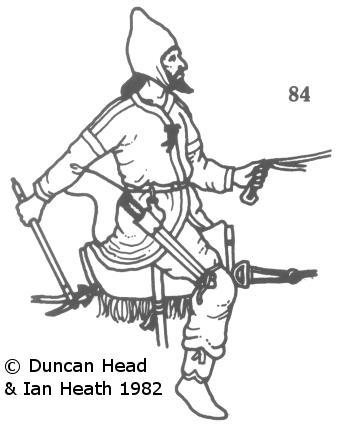
Find the perfect fit with Amazon Prime. Try Before You Buy.
SAKA HORSE ARCHER
An extract from Armies of the Macedonian and Punic Warsby Duncan Head, illustrated by Ian Heath
 84. SAKA HORSE ARCHER
84. SAKA HORSE ARCHER
 84. SAKA HORSE ARCHER
84. SAKA HORSE ARCHERThis man is from a relief of the Persian king Artaxerxes III Ochos (358-338). Costume and equipment are very similar to his western cousin, 76. The cap is taller, and Persian artists use different cap styles to denote different tribes. His coat is cut higher in front than at the back, almost like a tailcoat. His loose trousers are tucked into short leggings, tied at the top. The main weapon is a composite bow of the Scythian type, but he also carries a bronze-headed sagaris. This axe-like weapon has a point like a pick, balanced by a small hammerhead. It was used by the Saka and neighbouring nomad tribes in central Asia and Siberia, and adopted from them by Sarmatians and Persians, who used it occasionally. From his belt, which for a noble could be covered in gold plates, he wears an akinakes thonged to his right leg. The weapon has an iron blade and a bronze hilt with the pommel in the shape of a crouching ibex. One Saka on a Persian relief has his akinakes worn under his coat skirts, with only the chape of the scabbard visible.
Some Saka tribes at least could raise infantry, archers like this man and spearmen with light round shields, who are illustrated later in the art of Saka India.
The British Museum has a small bronze figurine from western Iran, dressed very like this figure, who may be an early Parthian, the Parthian state of course being founded by a Saka tribe. They originally used the Scythian style of bow, but somewhen before the mid 1st century BC had replaced it with a longer but less deeply recurved bow very like those previously used by the Persians. An example was found in the Yrzi necropolis on the banks of the Euphrates. It is 58"/1.47m long. Parthian bows seem to have been built longer and heavier than their Persian ancestors, and the effects reported in accounts of Parthian battles with Rome in the 1st century BC suggests they had greater penetrative power.